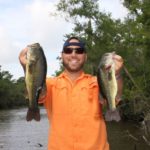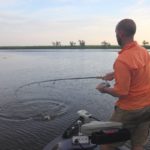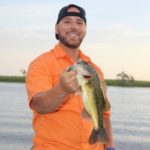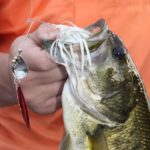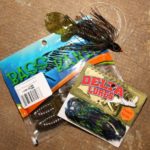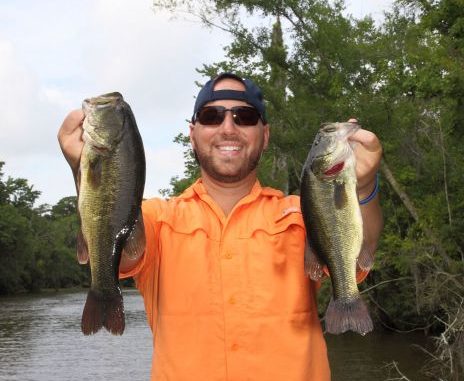
It’s no secret that the Bayou Black marshes offer great bass fishing, and boats often stack up in certain areas. But this young angler has learned to get off the beaten track to find unpressured fish.
Tyler Dupre is someone who would rather travel 50 miles by boat than in his vehicle, fishing bass since the age of 12, the 24-year-old is a lifelong resident of Houma who has a wealth of knowledge learned mostly from his grandfather about this particular species of fish.
Like a lot of local young people who grew up in the surrounding area, he attended Nichols State University majoring in safety technology, which led to employment with the fabrication service company Danos.
Perhaps most important was that his initial career path has kept him close to the Bayou Black region, where after work you’ll often find the angler.
There’s a certain demeanor required in being the safety guy for any company. There’s attention to detail. There’s meticulous analysis of key performance indicators. And there’s not taking things for granted.
In short, making sure safety operations are copacetic.
Cruising with Dupre at an easy 45 mph in his bass boat heading south on Bayou Copasaw, I almost thought I was fishing with a safe boating instructor. I had to admit it was a departure from other bass fishermen I’d been on the water with in the past.
With those other bass anglers, it didn’t matter that we were just leisurely out to catch a few largemouths and enjoy the day. Instead, they acted like it was a morning blast-off drill for a tournament. The G-forces from running 70 mph always left me white knuckled and thanking God my life insurance policy was current.
Dupre will be the first to tell you he isn’t a tournament angler. He didn’t enjoy the one time he entered a local tournament, though he placed second.
The catching part, though challenging, wasn’t as much the problem as the intensity required, he said.
On the contrary, Dupre prefers the relaxation of a leisurely day figuring bass out. The things his grandfather instilled in him — like the ethics of catching and releasing the right-sized fish and egg-laden females, the spawn, lures and baits, presentation, wind direction and an understanding of water conditions — are what drive him.
“I started fishing when I was a kid when my grandfather wanted to get me into it,” Dupre said. “He was a big fisherman back in the day. I fished with him a few years, and he became very ill with heart disease and eventually had to sell his boat.
“The things he taught me I really took to heart, and I learned a lot. The first time I ever caught a bass, it was like a thrill — it was a high to me — and ever since then I’ve been addicted. I’ve been in love with the sport and everything about. Just being out in nature and the challenge of bass fishing itself is what I prefer.”
The one thing I noticed on was that we passed up a number of the more-popular places where tournament bass anglers stop when it comes to putting pounds on the scale. Places like the Orange Grove, Turtle Bayou, Bluebird Canal and 7-Mile see their share of bass boats each spring and summer.
But, according to Dupre, that pressure stresses the fish.
“I try to go into areas a little farther away that are more remote,” he said. “I always try to stay away from the areas that have lots of pressure and instead look for places that are larger or vaster.
“There’s miscellaneous no-name canals and cuts in the marsh that people will pass up thinking there’s not much in there, where they’ll go to more popular places. I believe the fish get used to the stress in those heavily fished areas. They see the same lures and presentations over and over and over again, which makes it harder to catch those larger fish.
“Instead of the more-preferred named bayous and canals, I’ll go to these other outlying areas, and try and match my tactics based on what the conditions are at the time.”
Dropping his troll motor, Dupre and I started fishing a point where two canals off the Copasaw met. The warm weather had us fishing an early summer pattern with a bit of overcast starting out.
Almost immediately Dupre had a fish on, and I had a good strike that I didn’t set the hook on.
One thing was for sure: The lessons Dupre’s grandfather taught him stuck as well as the ACT score that got him into Nichols State. For not being a tournament angler he sure sounded like one after landing the first bass of the morning.
“I’ll look at the conditions in some of these other areas and go off that,” Dupre said. “I look for things like good water color and moving water near channels going in and out of the marsh.
“A bass is looking for shade and cooler areas, so in the summer when it starts to get hot I’ll fish cover. Some of that cover might be heavy grass beds, lily pads or beneath trees. But, I also won’t hesitate to fish currents and deeper water.”
Dupre spoke about presentation like he had taken an elective in theater back in Thibodaux.
“When it comes to hook size, I’ll use a No. 2 size with a 1/8-ounce bullet weight in shallow water, which I mostly fish,” he said. “I find it gives a better presentation, especially when you’re dealing with spooky bass in the summer. It doesn’t send off that vibration heavy baits and lures have.
“If I’m in 6 to 10 feet of water, I’ll switch to a ¼-ounce. And I’ll go to a 5/8-ounce in deeper water or where it has a lot of current.”
When it’s overcast, Dupre likes to start out with topwater baits early in the morning during the summer months. The angler works tried-and-true standbys like Rapalas and Heddon Torpedos before going deeper with a worm or his preferred bait — a Zoom Baby Brush Hog.
“I like Baby Brush Hogs in the summer,” Dupre said, “but sometimes I’ll also fish a Zoom 7-inch worm. I also like to fish crankbaits in deeper water or when it’s moving.
“And where I see bait fish running, I’ll use spinningbaits.”
When it comes to water clarity, Dupre said he doesn’t want to fish anything too murky; he prefers to see his bait.
But he explained that he doesn’t want the water to be too clear. He said when he can see 2 feet under the surface fish get spooky and tend not to be aggressive as they are when the water is stained.
“My perfect water would be like fresh-brewed coffee with a little hint of cream in it or sort of a dark grayish brown,” Dupre said. “At times, I’m willing to fish muddier water — perhaps more than most people I guess.
“I have always found muddy water can hold some big bass. But when I do fish muddy water, I’ll fish with darker baits or sometimes louder baits to get the fish’s attention. In that case it’ll be a spinningbait or something flashy.”
Dupre and I found some moving water at another canal intersection on the lower Copasaw.
This time we switched to crankbaits, as the water was deeper and flowing quite rapidly. Not surprisingly, Dupre had another fish on after tossing toward some oil-field structure.
A solid 3-pounder, the fish put up a short scrap, but the treble hooks on the crankbait was more than it was able to toss off.
Looking over the stocky marsh bass, Dupre explained his approach to this scenario.
“I love fishing a crankbait in moving water,” he said. “When water is coming out of a cut like that I like to get on the closest point and fish it.
“And, when the conditions are right, I usually catch every time.”
Throughout the day it was obvious by the things Dupre shared that his grandfather had made a lasting impression.
“He taught me how to drive a boat and things to look out for,” Dupre said. “He taught me what to do and what not to do, and how to get out of bad situations. He showed me the ropes of being on the water, and I took it from there.”
Dupre and I passed several areas in which other bass anglers were fishing on our quest to get off the beaten path down in the lower part of Capasaw Bayou. In fact, we fished some short dead-end places I’m not sure other anglers even considered.
And as we trolled — picking up a fish here and fish there on a slow day — I came to realize that, with Dupre, everything was copacetic on the Capasaw.
